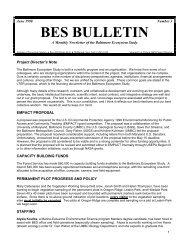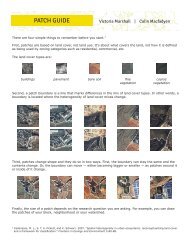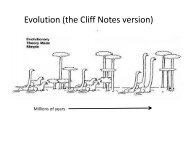Investigations in Urban Soils - Baltimore Ecosystem Study
Investigations in Urban Soils - Baltimore Ecosystem Study
Investigations in Urban Soils - Baltimore Ecosystem Study
Create successful ePaper yourself
Turn your PDF publications into a flip-book with our unique Google optimized e-Paper software.
<strong>Investigations</strong> <strong>in</strong> <strong>Urban</strong> <strong>Soils</strong>: Earthworm Populations<br />
Contributed by: Jenny Harvey, Barclay School (BES Ecology Education Fellow), Katal<strong>in</strong><br />
Szlavecz, Johns Hopk<strong>in</strong>s University (BES Co-Pr<strong>in</strong>cipal Investigator), and Richard Pouyat,<br />
USDA Forest Service (BES Co-Pr<strong>in</strong>cipal Investigator).<br />
Overview of Unit<br />
Students learn to sample for earthworms <strong>in</strong> various sites around their school, determ<strong>in</strong><strong>in</strong>g<br />
relative population size and habitat characteristics. Students compare their results to BES data<br />
and predict earthworm distribution <strong>in</strong> other urban habitats. Advanced students may also<br />
determ<strong>in</strong>e species composition and exam<strong>in</strong>e long-term trends.<br />
Table of Contents<br />
Sequence of Activities, Concepts, and Skills<br />
Alignment of Learn<strong>in</strong>g Objectives with State and National Standards-<br />
Earthworm Background for Teachers<br />
Read<strong>in</strong>gs and References<br />
Earthworm Populations Activities<br />
Interpret<strong>in</strong>g Results from 2003 – Teacher’s Commentary<br />
Curriculum Extensions<br />
Draft 2 - (9.28.04)<br />
<strong>Baltimore</strong> <strong>Ecosystem</strong> <strong>Study</strong> – <strong>Investigations</strong> <strong>in</strong> <strong>Urban</strong> <strong>Soils</strong><br />
page 15






